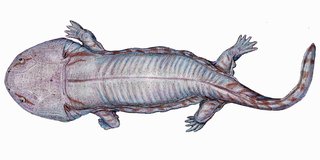
The Stereospondyli are a group of extinct temnospondyl amphibians that existed primarily during the Mesozoic period. They are known from all seven continents and were common components of many Triassic ecosystems, likely filling a similar ecological niche to modern crocodilians prior to the diversification of pseudosuchian archosaurs.

Prionosuchus is an extinct genus of large temnospondyl. A single species P. plummeri, is recognized from the Early Permian. Its fossils have been found in what is now northeastern Brazil.

Laidleria is an extinct genus of temnospondyl that likely lived between the Early to Middle Triassic, though its exact stratigraphic range is less certain. Laidleria has been found in the Karoo Basin in South Africa, in Cynognathus Zone A or B. The genus is represented by only one species, L. gracilis, though the family Laidleriidae does include other genera, such as Uruyiella, sister taxon to Laidleria, which was discovered and classified in 2007.

Pelorocephalus is an extinct genus of chigutisaurid temnospondyls. It is known from the Late Triassic (Carnian) Cacheutá Formation of the Cuyo Basin and the Ischigualasto Formation of the Ischigualasto-Villa Unión Basin, both in northwestern Argentina. Four species are currently recognized: the type species P. mendozensis, which was named in 1944, P. tenax, which was named in 1949 as a species of Chigutisaurus and reassigned to Pelorocephalus in 1999, and P. cacheutensis, which was named in 1953 as another species of Chigutisaurus and reassigned to Pelorocephalus along with P. tenax. A fourth species, P. ischigualastensis, was named in 1975 after the formation it was found in. The species P. tunuyanensis was named in 1948 but has since been synonymized with P. mendozensis.

Rhytidosteidae is a family of Temnospondyli that lived in the Permian and Triassic.

Brachyopoidea is a superfamily of temnospondyls that lived during the Mesozoic. It contains the families Brachyopidae and Chigutisauridae. The earliest records of brachyopids are from the Lower Triassic in Australia. The latest-surviving member of the superfamily is the chigutisaurid Koolasuchus from the Early Cretaceous of Australia.

Lydekkerinidae is a family of stereospondyl temnospondyls that lived in the Early Triassic period. During this time period, lydekkerinids were widely distributed, with putative remains reported from Russia, Greenland, India, South Africa, Madagascar, Australia, and Antarctica. In contrast to most other stereospondyls, lydekkerinids were relatively small-bodied. The type genus is Lydekkerina, the namesake of the family and the best-known lydekkerinid.

The Sanga do Cabral Formation is an Early Triassic sedimentary rock formation found in Rio Grande do Sul, Brazil.

Banksiops is an extinct genus of temnospondyl amphibian in the family Brachyopidae, recovered from the Knocklofty Formation, Tasmania.
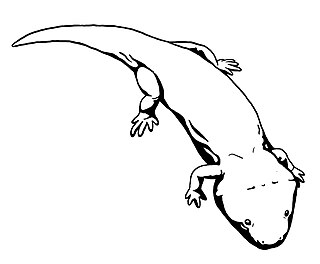
Indobrachyops is an extinct genus of temnospondyl amphibian from the Early Triassic of India. It is known from a nearly complete fossil skull that was first described by paleontologists Friedrich von Huene and M. R. Sahni in 1958 from the Panchet Formation in Raniganj Coalfield. Indobrachyops belongs to a group of mostly semi-aquatic temnospondyls called Stereospondyli, but its exact placement within the group has been uncertain since its first description.
Luzocephalus is an extinct genus of temnospondyl from the Early Triassic of Russia and Greenland. It is usually regarded as a member of the family Lydekkerinidae, although it has also been placed in the family Trematosauridae.
Pneumatostega is an extinct genus of rhytidosteid temnospondyl from the early Triassic period of Cape Province of South Africa. It is known from the holotype BPI F981, a dorsal mould of a skull roof and from the referred specimen SAM 11188, partial skull fragments and postcranial remains recovered from the Lystrosaurus Assemblage Zone in the Beaufort Group near Middelburg. This genus was named by J. W. Cosgriff and J. M. Zawiskie in 1979, and the type species is Pneumatostega potamia.
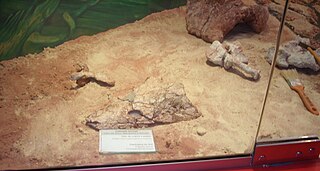
Sangaia is an extinct genus of rhytidosteid temnospondyl from the early Triassic period of Rio Grande do Sul, Brazil. It is known from the holotype UMVT 4302, the left half of a partial skull, a partial palate, from the paratype UMVT 4303, a partial right palatal fragment and from the referred specimens PV 0497 T and MCN PV 2606, skull fragments, recovered from the Sanga do Cabral Formation in the Rośario do Sul Group.

Trucheosaurus is an extinct genus of rhytidosteid temnospondyl from the Late Permian Glen Davis Formation of the Sydney Basin, New South Wales, Australia. It is known from the holotype materials MMF 12697a, a partially complete skull, AMF 50977, an articulated postcranial skeleton and BMNHR 3728, the counterpart of both skull and postcranial skeleton, recovered from the Glen Davis Formation. This genus was named by Watson in 1956, and the type species is Trucheosaurus major.
Pintosaurus is an extinct genus of basal procolophonid parareptile from Late Triassic deposits of northeastern Uruguay. It is known from the holotype FC-DPV 1181, a partial skull. It was collected from the Buena Vista Formation of the Paraná Basin, in Colonia Orozco, Cerro Largo Department. It was first named by Graciela Piñeiro, Alejandra Rojas and Martín Ubilla in 2004 and the type species is Pintosaurus magnidentis. The generic name honours Dr. Iraja Damiani Pinto. The specific name means "with a large tooth" in Latin, a reference to the large palatal tooth pair.
Arachana is an extinct genus of rhinesuchid-like temnospondyl known from the Early Triassic Buena Vista Formation of northeastern Uruguay. Arachana was first named by Graciela Piñeiro, Alejandro Ramos and Claudia Marsicano in 2012 and the type species is A. nigra. It shares characteristics with both rhinesuchids and lydekkerinids, making it a transitional form between basal and more advanced stereospondyls.
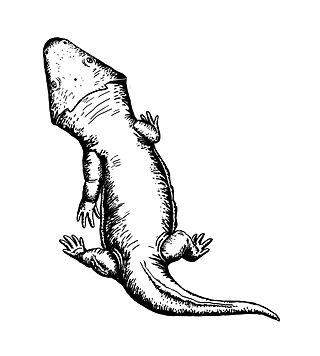
Derwentiinae is a subfamily of rhytidosteid temnospondyls from the Permian and Triassic periods of Australia and India. It includes the genera Arcadia, Deltasaurus, Derwentia, Indobrachyops, and Rewana. Derwentiinae was named in a 2011 study that analyzed the phylogenetic relationships of rhytidosteids. It was a replacement name for the family Derwentiidae, which was named in 2000.

Vigilius is an extinct genus of brachyopid temnospondyl amphibian from the Triassic of Arizona. It is known from the single type species Vigilius wellesi.
The Buena Vista Formation is a Late Permian-Early Triassic geologic formation of the Cerro Largo Department in northeastern Uruguay. The fluvial sandstones and mudstones preserve temnospondyl and archosaur fossils.
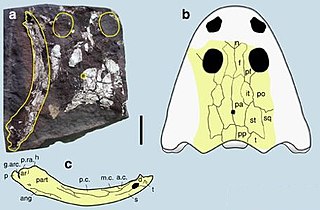
Procuhy is an extinct genus of dvinosaurian temnospondyl amphibian in the family Trimerorhachidae represented by the type species Procuhy nazariensis from the Early Permian of Brazil.















